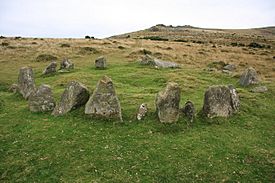Nine Maidens stone circle facts for kids

Nine Maidens stone circle
|
|
| Lua error in Module:Location_map at line 420: attempt to index field 'wikibase' (a nil value). | |
| Alternative name | Seventeen Brothers |
|---|---|
| Location | Belstone, Devon |
| Type | Stone circle |
| History | |
| Periods | Bronze Age |
The Nine Maidens is an ancient stone circle found near Belstone village in Devon, England. It is also known as the Seventeen Brothers. This special site was built during the Bronze Age, a time long ago when people first started using metal tools.
Experts believe the stone circle was once a burial place. It might have had a cairn (a pile of stones) over a kistvaen (a stone box for burials). Sadly, these parts have been damaged or removed over time.
Contents
Exploring the Nine Maidens Stone Circle
The Nine Maidens is not a complete circle today. You can see sixteen stones still standing. The circle is located west of Belstone village. It sits in an area with many loose rocks, called 'clitter'. This might have helped protect the stones from being taken away.
The stones are not very tall. Most are about three feet (one metre) high. The circle itself is about twenty-one feet (seven metres) wide. In 1848, a writer named Samuel Rowe described the stones. He said there were seventeen stones, with the tallest being only two and a half feet tall.
Some stones have fallen over since then. The Book of Belstone suggests there could be up to twenty stones if you count smaller ones. In 1930, Dora James wrote that four stones were broken in 1929.
Mysteries and Legends of the Stones
Local people are careful about changing the stones. They believe that anyone who moves or adds a stone might face a curse. For example, in 1985, a film crew added a stone. The only copy of their film, "The Circle of Doom," was then lost in the mail!
Ley Lines and Ancient Paths
The Nine Maidens stone circle is part of something called a ley-line. This is a straight line that connects many old and important sites. The St Michael's ley-line is very long. It stretches 350 miles across England. It goes from Land's End to Hopton-on-Sea.
This special line passes through many places named after St Michael. One famous spot is St Michael's Tower on Glastonbury Tor. The line even matches the sunrise on May 8th. This date was when the Catholic Church celebrated an important event about St Michael.
Dancing Stones Folklore
There are many old stories about the stones. One popular legend says the stones can dance! People used to say that the stone circles on Dartmoor were made when "wolves were on the hills."
A local tale says the stones dance every day at noon. The story goes that the Nine Maidens were once young women. They were turned into stone as a punishment. This happened because they danced on the Sabbath, a day meant for rest. They are now doomed to dance forever at noon. Sometimes, the story involves seventeen brothers instead of maidens. It is also said that the sound of nearby church bells can make them come alive.
Why the Name Changes
The number of stones in the name changes. This is explained by the dancing stones legend. People say the stones move too much to count them accurately! In 1892, John Chudleigh suggested another idea. He thought that warm air rising from the ground might make the stones seem to move. This could be why people believed they danced.
Old Trading Stories
Another idea for the name comes from ancient Phoenician traders. These traders visited Britain long ago to buy tin. They worshipped a god called Baal. Some think "Belstone" might come from "Baal's ton," meaning "Baal's settlement."
The stone circle could be linked to this idea. It is said that the Phoenicians dragged a stone shaped like a sacred bull to the top of the nearby hill. They then worshipped it there. Some people believe that locals later placed a stone there to make this legend come true.
Other ideas for the name "Belstone" exist. It could come from Old English words. "Belle" means bell and "stan" means stone. Sabine Baring-Gould thought this might refer to a logan stone. This is a large stone that can be rocked back and forth.
Poetry and the Maidens
A poem about the stones was written by Eden Phillpotts. It appears in "The Witchcraft and Folklore of Dartmoor." The poem describes the stones coming alive:
- And now at every Hunter's Moon
- That haggard cirque of stones so still
- Awakens to immortal thrill
- And seven small maidens in silver shoon
- Twixt dark of night and white of day
- Twinkle upon the sere old heath
- Like living blossoms in a wreath
- Then shrink again to granite grey.
- So blue-eyed Dian shall ever dance
- With Linnette, Bethkin, Jennifer,
- Arisa, Petronell and Nance.
The poem mentions seven maidens, which is different from nine or seventeen. This might be artistic freedom, or it could refer to another stone circle. A Hunter's moon is the first full moon after the harvest moon. This usually happens in October. In the Victorian era, archaeologists thought the stone circle might represent the full sun and full moon.

